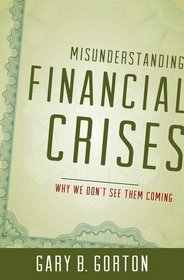
In Squaring Off, Zócalo invites authors into the public square to answer five questions about the essence of their books. For this round, we pose questions to Gary B. Gorton, the Frederick Frank Class of 1954 Professor of Management and Finance at the Yale School of Management and author of Misunderstanding Financial Crises: Why We Don’t See Them Coming.
Gorton argues that most post-mortems of the recent financial crisis failed to recognize the culpability of what he calls “the shadow banking system” and new-fangled forms of debt. He believes these innovations are necessary to markets, and mustn’t be done away with, but that we need to properly regulate them so that we know when they’re about to cause a modern run on the banks—the kind of run that even George Bailey in his most persuasive folksy tone can’t stop.


-
Given what the financial crisis taught us (or should have taught us), what is the most important policy prescription to help us predict (and, we hope, avert) the next financial crisis?
The most important lesson of the financial crisis is that financial crises can still happen in developed countries. Since the U.S. had a long period of quiet from 1934 (when deposit insurance was adopted) until 2007, the recent crisis seems, to many people, to be somehow unprecedented. This view is incorrect. All financial crises are at root bank runs. The recent crisis is no exception, but it occurred with a different kind of money and a different kind of bank. The recent crisis involved a form of bank money that is used by large entities, like money market funds, institutional investors, and firms. The run did not involve people lining up at banks but involved the withdrawal of funds by these entities. This was not observed by outsiders, who only saw the effects of the run—failure and trouble at large financial firms. The effects were then mistaken for the cause. This is why most observers must resort to superficial explanations for the crisis. Policy should follow from the correct diagnosis of the problem. The problem is that short-term bank debt is vulnerable to runs. We must bring asset-backed securities under the regulatory umbrella in order to oversee the collateral that backs the money at the root of the recent crisis. -
Is your recommendation to update the existing regulatory structure so as to adapt to these “new forms of bank money”?
Our recommendation aims to oversee the shadow banking system, which uses asset-backed securities as the collateral for short-term bank debt. “Asset-backed securities” (ABS) refers to bonds that are backed by portfolios of bank loans. The process of creating these bonds is called “securitization.” In the old days, banks would make loans and mortgages and hold them on their balance sheets until maturity. That is not modern banking. Now, banks make the credit decision to grant the loan and then fund it by securitizing the loans. As of April 2011, there was $11 trillion of outstanding securitized assets, including residential mortgage-backed securities (RMBS), other ABS, and asset-backed commercial paper (ABCP). A large fraction of consumer credit in this country, between 30 and 75 percent of lending in various consumer lending markets and about 64 percent of outstanding home mortgages, was financed via securitization. We propose a new kind of bank that is very narrow and limited. All ABS would be sold to one of these banks. The government would oversee and regulate these banks. The regulators would have to approve what ABS could be purchased and in what proportions. These banks would have capital requirements. They would also have access to the discount window. This would be a positive, constructive step toward rebuilding confidence in the banking system. -
How does or doesn’t Dodd-Frank, as the financial reform passed by Congress is known, address your recommendations?
Dodd-Frank does not address the root cause of the crisis. Rather than focus on crisis prevention, the reform seems more concerned with quickly liquidating banks in a crisis. The Volcker Rule, meanwhile, aims to prevent proprietary trading—the bets the banks make for themselves—which no one ever claimed had anything to do with the crisis. But the verdict isn’t entirely in, as some rules contemplated by the law are still being written. One important part of Dodd-Frank is that it establishes the “Office for Financial Research” as part of the Treasury. This new office with potentially broad powers could build a new measurement system so that we can measure risk rather than cash balance sheet items. Such a system is needed in the world with derivatives and off-balance sheet vehicles. -
But wasn’t part of the allure of these assets that they were beyond the reach of nettlesome regulators?
Well, at the time they were perceived to be rather safe. There is a global demand for what economists call “safe assets” such as U.S. Treasury bills. Safe assets are highly liquid because their value is certain. Large entities like China, sovereign wealth funds, pension funds, and corporations essentially use safe assets as money because there are no insured bank accounts large enough for them. But there are also privately produced “safe assets.” In fact, history shows that when there is not enough government debt outstanding, the private sector creates its own safe assets. A privately produced safe asset is a bond which has an almost certain value. It is not questioned but accepted like a Treasury bill or bond. Market participants understand, or should understand, the obvious point that privately produced safe assets are not riskless. Prior to the 2007 to 2009 financial crisis, AAA/Aaa asset-backed securities became private substitutes for government safe debt. But privately produced safe assets have inherent risks. The realization that such private securities were not safe was the beginning of the most recent crisis. Now there is a global shortage of safe assets. And eventually the private sector will produce substitutes. Before the crisis, regulators completely missed the growth of shadow banking, the combination of short-term debt backed by asset-backed securities. There is still no oversight of this market. -
What led to the “realization that such private securities were not safe”?
The realization that AAA/Aaa asset-backed securities linked to mortgages were riskier than previously thought came when house prices started to decline. These bonds had been viewed as near-riskless. In fact, the realized losses to date on AAA/Aaa subprime bonds are fairly modest, so there was a huge overreaction. The same problem recently occurred in Europe, where the sovereign debt of some countries is no longer viewed as a safe asset. There are limits to the government’s production of safe assets, too. In the U.S. we may see this problem occur if the debt ceiling problem is not resolved.



